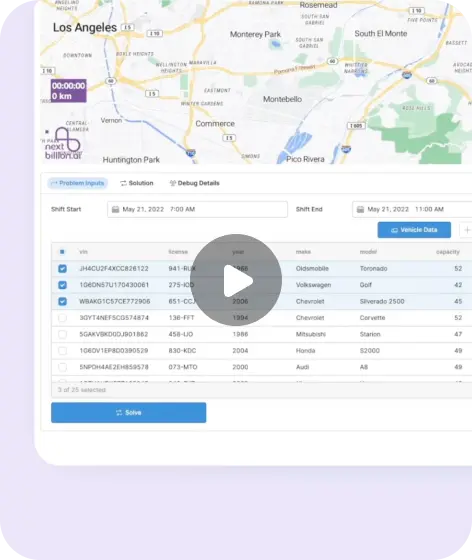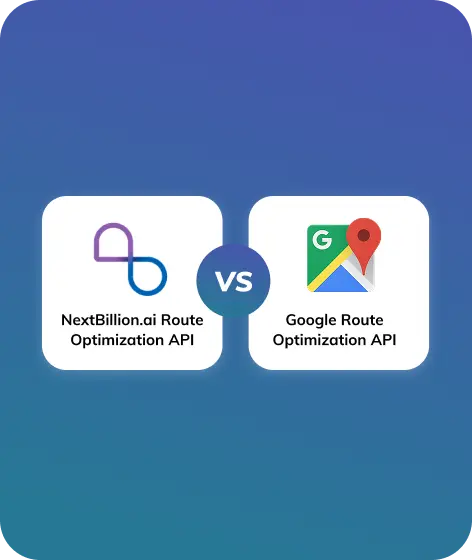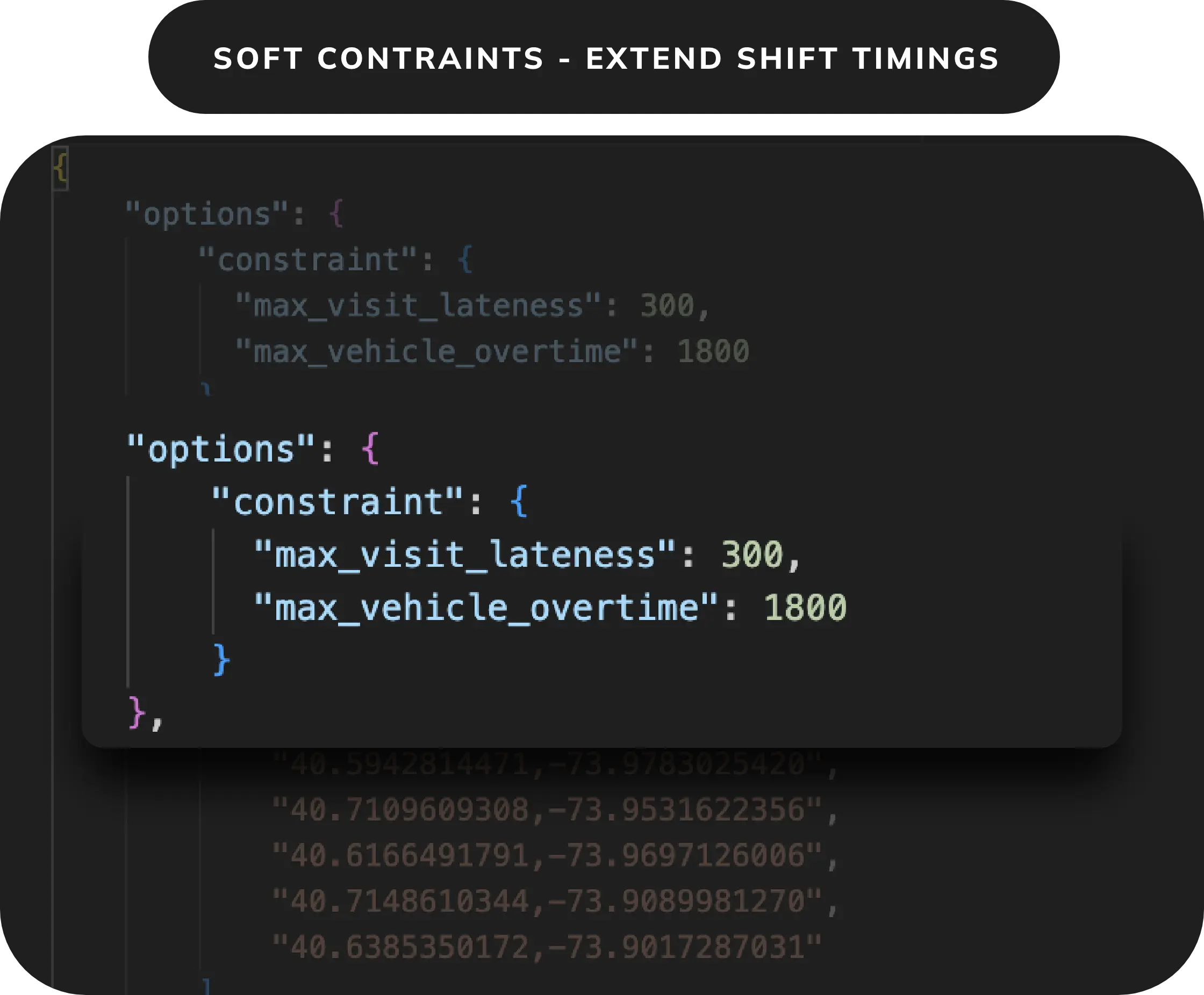
Table of Contents
When it comes to route optimization, there’s no one-size-fits-all solution. Whether you’re managing city-wide waste collection, utility services, or last-mile deliveries, choosing the right software can make or break your operations.
RouteSmart and NextBillion.ai are two powerful—but very different—players in this space. One is deeply rooted in GIS and enterprise systems. The other is built API-first for flexibility, real-time data, and rapid scaling.
In this comparison, I’ll break down how each platform stacks up across features, integrations, and pricing—so you can decide which tool aligns best with your business needs.
RouteSmart vs NextBillion.ai Features
In this section, I’ll do a head-to-head comparison of the core features each platform offers. Let’s begin by reviewing the top features of NextBillion.ai and then dive into RouteSmart’s capabilities.
NextBillion.ai Features
The following features stand out for NextBillion.ai’s Route Optimization API.

1. Flexible Route Optimization API
NextBillion.ai offers a powerful and developer-friendly Route Optimization API that supports both single and multi-vehicle routing. It works with structured JSON input and allows you to define and manage a variety of logistics parameters.
How it’s used:
The API is built around core objects such as locations, vehicles, jobs, shipments, depots, and relations. You can customize every aspect of the routing problem:
- Assign vehicle capacities (even in multiple dimensions like weight, volume, or pallets)
- Set time windows for job deliveries or pickups
- Define depots as start/end points or intermediate hubs
- Use the relations object to manage task sequences and job dependencies
- Tailor routing objectives using the options and objective objects
- Dynamically re-optimize using solution and unassigned attributes
Why it’s important: This level of flexibility allows businesses to build logistics workflows that truly match their operational needs—whether you’re managing parcel delivery, food distribution, waste collection, or industrial shipments.
2. Dynamic Constraints Handling
The API supports more than 50 configurable constraints that can be applied in real time. These include avoiding tolls, highways, ferries, sharp turns, U-turns, and specific zones or geofences.
How it’s used:
Constraints are defined within the options object and can be adjusted per API request. For example, you can:
- Avoid toll roads in one country and allow them in another
- Disable U-turns for large trucks while allowing them for bikes
- Prevent routing through restricted zones using the zones parameter
- Configure custom time windows and vehicle restrictions by job or region
Why it’s important:
Real-time, fine-grained constraint control enables businesses to comply with local laws, customer SLAs, and vehicle limitations—without needing to redesign the entire optimization setup.

3. Advanced Cost and Distance Matrix Customization
NextBillion.ai supports custom cost_matrix, distance_matrix, and duration_matrix inputs to override default travel calculations and reflect real-world or business-specific travel logic.
How it’s used: You can define your own 2D matrices where each element represents the cost, distance, or time between two points. These are especially useful in:
- Custom pricing models (e.g., tolls, fuel, traffic penalties)
- Service areas with unreliable map data
- Simulating travel costs under different delivery scenarios.
Custom matrices let you optimize based on real business constraints rather than generic map data. This helps improve cost accuracy, resource allocation, and delivery performance.
4. Multi-Dimensional Load Planning
The API supports multi-dimensional parameters like capacity, amount, and skills, allowing you to model and plan for real-world constraints in a detailed way.
How it’s used: You can define:
- Vehicle capacity across weight, volume, pallets, etc.
- Shipment amounts in multiple units (e.g., [100 kg, 2 m³, 3 boxes])
- Driver or vehicle skills like refrigeration, hazardous material handling, or package size limits
The solver then automatically matches shipments to vehicles with the right capabilities, ensuring the optimization respects all constraints.
Multi-dimensional load planning helps maximize asset utilization and avoid overloading or skill mismatches. It’s critical for businesses dealing with complex logistics like cold chain, construction, or bulk delivery.
NextBillion.ai is the right choice if:
✅ You want complete control over route optimization parameters
✅ You’re building a modern logistics platform with real-time data
✅ You operate in dynamic, high-volume environments like last-mile delivery or field services
NextBillion isn’t the best option if:
❌ You rely heavily on Esri’s ArcGIS system
❌ You’re looking for a legacy, all-in-one desktop-based solution
❌ You prefer fully managed turnkey software over an API-first product
RouteSmart Features

1. GIS-Based Routing with ArcGIS Integration
RouteSmart offers native integration with Esri’s ArcGIS platform. This integration allows planners to build, visualize, and edit routes directly within the GIS interface.
How it’s used: Users can plan and optimize routes in a spatially rich environment, incorporating layers like traffic flow, land use, or zoning directly from ArcGIS. This makes it especially valuable for public sector users or large municipalities who already rely on ArcGIS as their spatial backbone.
Why this is important: By embedding routing capabilities into the same system where geographic data is managed, RouteSmart ensures better accuracy, smoother workflows, and minimal context switching.
Comparison: This GIS-first approach contrasts with NextBillion.ai’s API-first design, which does not require GIS software and is better suited for dynamic, app-driven ecosystems.
2. High-Density Routing Algorithms
RouteSmart is built to optimize routing for high-density service areas, particularly industries like waste collection, postal delivery, and utility services.
How it’s used: The system supports side-of-street servicing, route sequencing, and turn minimization to optimize static, complex routes. Planners can generate consistent daily or weekly plans that consider traffic, servicing rules, and workload balancing.
Why this is important: These algorithms are purpose-built for dense urban delivery or field service operations where routes repeat and compliance with detailed operational rules is essential.
Comparison: Unlike NextBillion.ai, which is designed for flexibility and real-time re-optimization, RouteSmart’s algorithms are best suited for static or recurring service routes with high density and strict servicing constraints.
3. RouteSmart RaaS (Routing as a Service)
RouteSmart RaaS is an API-accessible routing engine that lets businesses embed RouteSmart’s solvers into their own GIS tools or enterprise applications.
How it’s used: Developers and IT teams can connect their SAP, Oracle CC&B, Hansen, or custom systems to RouteSmart’s API. It provides access to route planning, geocoding, location services, and historical traffic data—all integrated into the host environment.
Why this is important: Organizations don’t need to overhaul existing infrastructure to adopt route optimization. RaaS acts as a backend service that automates daily workload planning and field operations using tools that businesses already know and trust.
Comparison: While RouteSmart RaaS offers solid API-based integration, its focus remains GIS-centric. NextBillion.ai, on the other hand, is built entirely around flexible, headless API deployment across logistics and delivery platforms, not just GIS environments.
RouteSmart is the right choice if:
✅ Your business depends on GIS for route planning
✅ You operate in municipal/public works, postal or utility sectors
✅ You need enterprise-grade integration with legacy systems
RouteSmart isn’t the best option if:
❌ You need a flexible, API-first route planning solution
❌ You want real-time dynamic rerouting
❌ You’re scaling a tech-driven delivery platform or on-demand service
RouteSmart vs NextBillion.ai Integrations
When choosing a route optimization solution, integration capabilities are key. Both RouteSmart and NextBillion.ai offer robust options—but they serve different types of tech environments. RouteSmart leans into GIS platforms and legacy enterprise systems, while NextBillion.ai is designed for flexibility with modern, API-first architectures. Let’s break down how each platform fits into various business ecosystems.
NextBillion.ai Integrations

NextBillion.ai can integrate with telematics providers like Geotab, Samsara, and Motive, allowing for live vehicle data to influence routing decisions. These integrations enable syncing of real-time telemetry data for dynamic routing and compliance tracking.
How it’s used: Live vehicle location, fuel levels, engine status, and more can be passed into the route optimization engine. This enables:
- Real-time route adherence tracking
- Dynamic re-optimization when delays or incidents occur
- Monitoring driver behavior and ETA accuracy
This level of integration bridges the gap between static route planning and live operations—making your routing system responsive and adaptive to real-world conditions.
RouteSmart Integrations
RouteSmart is built to integrate seamlessly with traditional enterprise and GIS-based environments. Its deep connection with Esri’s ArcGIS platform allows users to visualize, edit, and manage routes directly within familiar GIS interfaces—ideal for teams already using spatial data tools.
In addition to GIS, RouteSmart supports integration with major enterprise systems like SAP, Oracle CC&B, and Hansen. These integrations are enabled via RouteSmart RaaS (Routing as a Service), an API-based solution that allows route planning to be embedded into existing IT infrastructure. This means organizations can automate route planning, workload balancing, and service sequencing directly from their current back-office systems—no need for major reengineering.
These integration capabilities make RouteSmart especially well-suited for utilities, postal services, and municipal operations that rely on legacy systems and structured workflows.
RouteSmart vs NextBillion.ai Pricing
When it comes to pricing, RouteSmart and NextBillion.ai take very different approaches—one focused on enterprise contracts, the other offering flexible, tiered API pricing.
NextBillion.ai Pricing
NextBillion.ai offers a more modular and scalable pricing model through its tiered Route Optimization API plans, designed to support a range of logistics use cases—from startups to enterprise-level operations. The tiers include:
- Basic: For simple, intra-city delivery routing. Offers car routing, basic optimization, and traffic-aware ETAs.
- Advanced (Most Popular): For complex, multi-vehicle routing. Includes truck profiles, advanced optimization, and complete route planning APIs.
- Bespoke: For high-scale, cross-border logistics. Comes with AI-enhanced traffic data, custom deployment options, and white-glove support.
Each plan includes access to:
- Route Optimization & Distance Matrix APIs
- Vehicle-specific routing profiles
- Map customization options
- Integration capabilities
- Varying levels of support (from basic to personalized)
This pricing structure gives logistics teams more flexibility, especially for dynamic, fast-scaling, or on-demand operations that may not want to commit to long-term contracts upfront.
RouteSmart Pricing
RouteSmart does not publicly list detailed pricing on its website, but pricing details are available through its AWS Marketplace listing for RouteSmart RaaS (Routing as a Service). Pricing is contract-based, with costs depending on the number of technicians or meter readers and the length of your agreement. Key pricing examples include:
- Field Tech (up to 25 stops per day):
$1,650/year per technician (minimum of 5 techs) - Meter Reader/Field Tech (unlimited stops):
$6,600/year per technician (minimum of 10 techs)
This model is best suited for large, structured organizations with long-term, high-volume routing needs—especially in utilities, postal services, and municipal operations.
Bottom Line
- RouteSmart is ideal for organizations with predictable, static routing needs and existing contracts with legacy systems. Pricing is structured and volume-based, best for field teams with set schedules and routes.
- NextBillion.ai suits modern, fast-moving logistics operations that require agility, API-first integrations, and scalable pricing based on usage and complexity.
If your team values contract stability and GIS integration, RouteSmart delivers. If you prefer API flexibility, transparent pricing tiers, and rapid deployment, NextBillion.ai offers more freedom to scale on your terms.
Wrapping Up
If you’re running a logistics company that thrives on flexibility, real-time data, and advanced customization, NextBillion.ai offers unmatched control and modern infrastructure to build your ideal routing workflow.
On the other hand, if your organization is rooted in GIS workflows or municipal services with fixed routes, RouteSmart may be a better fit due to its tight ArcGIS integration and field-specific algorithms.
Choose the solution that fits your technology ecosystem and business model—both tools have their place, but only one is likely the perfect match for your unique needs.
About Author
Shivangi Singh
Shivangi is a seasoned Technical Writer with a passion for simplifying technical concepts. With over 5 years of experience, she specializes in crafting clear and concise documentation for various technical products and platforms.











